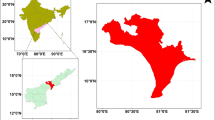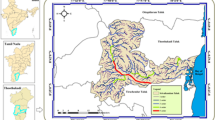Abstract
Among the most devastating natural disasters, flood stands tall. India is one of the countries affected by flood almost every year. Inclusive flood management is necessary to retard the implications of the vulnerability over the human lives and livelihoods. The objective of present study is to demarcate and categorize the flood hazard and risk assessment zones using analytical hierarchy process (AHP) and geographical information (GIS) in the Adayar River basin, Tamilnadu, India. Integrating AHP with GIS provides more optimum decisions to the decision-makers to evaluate the effective factors. The study area is an urbanized watershed, which lies between 12° 45′–13° 15′N latitude and 79° 50′–80° 15′E longitude covering a total geographical area of 830 km2. The flood inventory map was prepared by using extensive field data collected in 2015 December flood event. Nine base layers such as rainfall, elevation, land-use, lithology, distance from rivers, soil texture, slope angle, drainage density and topographic wetness index (TWI) were prepared from the spatial database using ArcGIS 10.4. Flood frequency map was generated from the long-term observed rainfall data. Flood inundated areas were classified as very low, low, moderate, high and very high based on its susceptibility to the probability of flood hazard. Suitable scores were assigned to each class for determination of risk zone. The incorporation of all thematic layers and the generated flood frequency map was used to prepare the flood susceptibility and flood hazard using GIS platform. Results indicated that the flood susceptibility zone in different scales, i.e. very high 30,200 ha (36.39%), high susceptibility 9,400 ha (11.33%), moderate susceptibility 15,200 ha (18.31%), low susceptibility 17,900 ha (21.57%) and very low susceptibility 10,300 ha (12.41%). The final suitability model outputs were compared with field data and are acknowledged as a useful product for the district planners to take the necessary steps to manage the flood susceptible areas from damages by implementing of flood controllers and prevention measures.
Access this chapter
Tax calculation will be finalised at checkout
Purchases are for personal use only
Similar content being viewed by others
References
Bronstert A (2003) Floods and climate change: interactions and impacts. Risk Anal 23:545–557
Gokceoglu C, Sonmez H, Nefeslioglu HA, Duman TY, Can T (2005) The 17 March 2005 Kuzulu Landslide (Sivas, Turkey) and landslide-susceptibility map of its near vicinity. Eng Geol 81:65–83
Greenbaum, D. (1989). Hydrogeological applications of remote sensing in areas of crystalline basement. In: Proceedings groundwater exploration and development in crystalline basement aquifers, Zimbabwe
Gül GO (2013) Estimating flood exposure potentials in Turkish catchments through index-based flood mapping. Nat Hazards 69:403–423
Hong H, Tsangaratos P, Ilia I, Liu J, Zhu AX, Chen W (2018) Application of fuzzy weight of evidence and data mining techniques in construction of flood susceptibility map of Poyang County, China. Sci Total Environ 625:575–588
Indian Air Force (2015) Aerial view of submerged Chennai airport taken by Indian Air Force helicopters following heavy rains in Tamil Nadu, 2 December 2015. https://en.wikipedia.org/wiki/2015_South_Indian_floods#/media/File:Chennai_Airport_submerged_during_December_2015_Tamil_Nadu_flood.jpg Published under Government Open Data License—India (GODL)
Khosravi K, Nohani E, Maroufinia E, Pourghasemi HR (2016) A GIS-based flood susceptibility assessment and its mapping in Iran: a comparison between frequency ratio and weights-of-evidence bivariate statistical models with multi-criteria decision-making technique. Nat Hazards 83(2):947–987
Kia MB, Pirasteh S, Pradhan B, Mahmud AR, Sulaiman WNA, Moradi A (2012) An artificial neural network model for flood simulation using GIS: Johor River Basin, Malaysia. Environ Earth Sci 67:251–264
Kron W (2002) Keynote lecture: flood risk = hazard * exposure * vulnerability. In: Proceedings of the flood defence. Science Press, New York
Liu YB, Gebremeskel S, De Smedt F, Hoffmann L, Pfister L (2003) A diffusive transport approach for flow routing in GIS-based flood modeling. J Hydrol 283(1–4):91–106
Maidment DR, Olivera F, Calver A, Eatherall A, Fraczek W (1996) Unit hydrograph derived from a spatially distributed velocity field. Hydrol Process 10(6):831–844
Malczewski J (1999) GIS and multi-criteria decision analysis. Wiley, New York
Muzik I (1996) A GIS-derived distributed unit hydrograph. IAHS Publ-Ser Proc Rep-Intern Assoc Hydrol Sci 235:453–460
Noto LV, La Loggia G (2007) Derivation of a distributed unit hydrograph integrating GIS and remote sensing. J Hydrol Eng 12(6):639–650
Papaioannou G, Vasiliades L, Loukas A (2015) Multi-criteria analysis framework for potential flood prone areas mapping. Water Resour Manage 29(2):399–418
Patel DP, Srivastava PK (2013) Flood hazards mitigation analysis using remote sensing and GIS: correspondence with town planning scheme. Water Resour Manage 27(7):2353–2368
Pradhan B (2010) Flood susceptible mapping and risk area delineation using logistic regression, GIS and remote sensing. J Spat Hydrol 9(2)
Rahmati O, Pourghasemi HR, Zeinivand H (2015) Flood susceptibility mapping using frequency ratio and weights-of-evidence models in the Golastan Province, Iran. Geocarto Int 31(1):42–70
Saaty TL (1980) The analytical hierarchy process. McGraw-Hill, New York
Samanta RK, Bhunia GS, Shit PK, Pourghasemi HR (2018a) Flood susceptibility mapping using geospatial frequency ratio technique: a case study of Subarnarekha River Basin, India. Model Earth Syst Environ 4(1):395–408
Samanta S, Pal DK, Palsamanta B (2018b) Flood susceptibility analysis through remote sensing, GIS and frequency ratio model. Appl Water Sci 8(2):66
Sanyal J, Lu X (2004) Application of remote sensing in flood management with special reference to monsoon Asia: a review. Nat Hazards 33:283–301. https://doi.org/10.1023/B:NHAZ.0000037035.5105.95
Saravanan S, Ahmed Z, Jain MK (2006) Modeling of flood events using spatially distributed unit hydrograph. In: Agriculture and hydrology applications of remote sensing, vol 6411. International Society for Optics and Photonics, p 641114
Stefanidis S, Stathis D (2013) Assessment of flood hazard based on natural and anthropogenic factors using analytic hierarchy process (AHP). Nat Hazards 68(2):569–585
Tehrany MS, Pradhan B, Jebur MN (2013) Spatial prediction of flood-susceptible areas using rule-based decision tree (DT) and a novel ensemble bivariate and multivariate statistical models in GIS. J Hydrol 504:69–79
Tehrany MS, Pradhan B, Jebur MN (2014) Flood susceptibility mapping using a novel ensemble weight of-evidence and support vector machine models in GIS. J Hydrol 512:332–343
Tehrany MS, Pradhan B, Jebur MN (2015) Flood susceptibility analysis and its verification using a novel ensemble support vector machine and frequency ratio method. Stoch Env Res Risk Assess 29(4):1149–1165
WHO: World Health Organization (2003) World disasters report, Chapter 8: disaster data: key trends and statistics. http://www.ifrc.org/PageFiles/89755/2003/43800-WDR2003_En.pdf
Author information
Authors and Affiliations
Corresponding author
Editor information
Editors and Affiliations
Rights and permissions
Copyright information
© 2020 Springer Nature Singapore Pte Ltd.
About this paper
Cite this paper
Subbarayan, S., Sivaranjani, S. (2020). Modelling of Flood Susceptibility Based on GIS and Analytical Hierarchy Process—A Case Study of Adayar River Basin, Tamilnadu, India. In: Pal, I., von Meding, J., Shrestha, S., Ahmed, I., Gajendran, T. (eds) An Interdisciplinary Approach for Disaster Resilience and Sustainability. MRDRRE 2017. Disaster Risk Reduction. Springer, Singapore. https://doi.org/10.1007/978-981-32-9527-8_6
Download citation
DOI: https://doi.org/10.1007/978-981-32-9527-8_6
Published:
Publisher Name: Springer, Singapore
Print ISBN: 978-981-32-9526-1
Online ISBN: 978-981-32-9527-8
eBook Packages: Earth and Environmental ScienceEarth and Environmental Science (R0)




